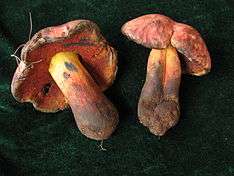Suillellus queletii
Suillellus queletii (formerly Boletus queletii), commonly known as the deceiving bolete, is an uncommon, edible mushroom in the genus Suillellus.
| Suillellus queletii | |
|---|---|
 | |
| Scientific classification | |
| Kingdom: | |
| Division: | |
| Class: | |
| Order: | |
| Family: | |
| Genus: | |
| Species: | S. queletii |
| Binomial name | |
| Suillellus queletii (Schulzer) Vizzini, Simonini & Gelardi (2014) | |
| Synonyms[1] | |
| |
Naming
Originally described by Stephan Schulzer von Müggenburg in 1885 as a species of Boletus, the fungus was transferred to Suillellus in 2014. The epithet queletii was given in honour of Lucien Quélet.[2][3]
In 1796 Christiaan Hendrik Persoon described a type of bolete under the name Boletus erythropus and in the next 200 years the same name was widely used for a well-known species having red pores. But recently it was discovered that Persoon's mushroom had orange pores, that usage of the name B. erythropus was invalid, and now the red-pored species (after a separate change to the genus too) has to be called Neoboletus luridiformis). It is best not to use the ambiguous name Boletus erythropus any more, but according to Funga Nordica the fungus described by Persoon was actually Suillellus queletii.[4][5][6]
Description
The cap is hemispherical, latter flattening out, appearing olive to reddish-brown, rarely also dark red. The flesh is yellow, turning blue when cut. The pores are initially yellow, soon become orange, and finally can be reddish.[7] The stipe is smooth and golden yellow and the flesh has a slightly acrid taste.[8]
The spore powder is olive and under the microscope the spores appear somewhat spindle-shaped and measure about 10-14 µm × 5-7 µm.[7][4]
This mycorrhizal mushroom can be found in deciduous forest, at lower altitudes, under beech, oak or hazel. [7][4]
It is uncommon in Europe and considered endangered in the Czech Republic.[9] In Asia, it has been recorded in Taiwan.[10]
References
- "GSD Species Synonymy: Suillellus queletii (Schulzer) Vizzini, Simonini & Gelardi". Species Fungorum. CAB International. Retrieved 2014-11-24.
- Schulzer S. (1885). "Einige neue Pilz-Species und Varietäten aus Slavonien". Hedwidia (in German). 24 (4): 129–151 (see p. 143).
- Vizzini A. (2014). "Nomenclatural novelties" (PDF) (188). Index Fungorum: 1. ISSN 2049-2375. Cite journal requires
|journal=(help) - Knudsen, Thomas; Vesterholt, J., eds. (2018). Funga Nordica Agaricoid, boletoid, clavarioid, cyphelloid and gasteroid genera. Copenhagen: Nordsvamp. p. 218. ISBN 978-87-983961-3-0.
- "the Suillellus queletii page". Species Fungorum. Royal Botanic Gardens Kew. Retrieved 2020-05-29.
- Species Fungorum actually has a page for an 1801 use of the name Boletus erythropus for Suillellus queletii, see "Boletus erythropus sensu Persoon ..." Species Fungorum. Royal Botanic Gardens Kew. Retrieved 2020-05-31.
- Eyssartier, G.; Roux, P. (2013). Le guide des champignons France et Europe (in French). Belin. p. 98. ISBN 978-2-7011-8289-6.
- Garnweidner E. (1994). Mushrooms and Toadstools of Britain and Europe. Collins.
- Mikšik M. (2012). "Rare and protected species of boletes of the Czech Republic". Field Mycology. 13 (1): 8–16. doi:10.1016/j.fldmyc.2011.12.003.
- Yeh K-W, Chen Z-C. (1980). "The boletes of Taiwan" (PDF). Taiwania. 25 (1): 166–184.